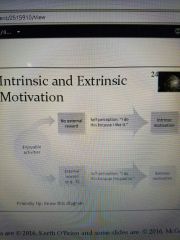![]()
![]()
![]()
Use LEFT and RIGHT arrow keys to navigate between flashcards;
Use UP and DOWN arrow keys to flip the card;
H to show hint;
A reads text to speech;
40 Cards in this Set
- Front
- Back
- 3rd side (hint)
|
Conformity |
Acting or thinking differently from the way you would act and think if you were alone |
Are your behaviors the same? |
|
|
Compliance |
Insincere, outward conformity |
Putting on a necktie |
|
|
Obedience |
Compliance to an explicit command |
Direct order |
|
|
Acceptance |
Genuine belief in what the group has persuaded us to do. |
Inward conformity |
|
|
A-B-Cs of Attitude |
Affect, behavior, cognition |
Often do not correspond |
|
|
Attitude |
Favorable or unfavorable evaluative reaction to someone or something |
Evaluative |
|
|
Expressed Attitudes |
Imperfectly predict our behavior, because both are subject to other influences |
Imperfect |
|
|
Attitudes predict behavior |
1. Social influence on the attitude is minimal 2. Non-attitudinal influences on the behavior are minimal 3. Attitudes specific to the behavior are examined 4. Attitudes are potent 5. Prejudicial attitudes predict discriminatory behavior |
5 ways |
|
|
Theory of Planned Behavior |
Attitudes predicting behavior. Attitude towards behavior, subjective norms & perceived control -> behavior intention-> behavior |
Running |
|
|
Behavior affecting attitudes |
Role playing/when saying becomes believing/foot-in-the-door/evil & moral acts/social movements |
Roles |
|
|
Role |
A set of norms defining how people in a given social position ought to behave |
Social expectations |
|
|
Zimbardo |
Stanford prison study. 1971. The power of the situation |
Connection of roles and behaviors |
|
|
Self-presentation theory |
Appear consistent with their actions |
Impression management |
|
|
Cognitive Dissonance Theory |
We feel tension after acting contrary to our attitudes or making difficult decisions so we internally justify our behavior |
Leon Festinger |
|
|
Insufficient Justification |
Reduction of dissonance by internally justifying one's behavior when external Justification is insufficient |
$1 v $20 boring task |
|
|
Overjustification |
Can reduce inteinsic motivations |
|
|
|
Self-perception Theory |
When our attitudes are weak we observe our behavior & its circumstances, then infer our attitudes |
Unsure of our attitudes |
|
|
Intrinsic & Extrensic Motivation |

|
Diagram |
|
|
Why does action affect attitudes |
Self-presentation, self-justification, self-perception |
3 theories |
|
|
Impression Management |
Concious or subconscious attempt to influence perceptions of other people about a person, object or event by regulating & controlling info in social interaction |
|
|
|
Selective Exposure |
Tendency to seek info & media that agree with one's view & avoid dissonant info |
|
|
|
Comparing dissonance, self-perception & Self-presentation |
Dissonance predicts attitude change. Self-perception predicts attitude formation. Dissonance is an arousal state. Self affirmation |
|
|
|
Complications with Likert scales |
Non-attitudes/satisficing |
"3" |
|
|
Osgood semantic differential |
Target item. Antonymous pairs of adjectives. Complications: Non-attitudes & satisficing |
|
|
|
Unobtrusive Measures |
Collected without participants knowledge. Complications: validity & ethical |
|
|
|
Sequence of studies |
Serif, Asch, Milgram, Zimbardo |
Conceptual relationship= behavior & attitudes are mutually reinforcing. The power of the situation |
|
|
Group size |
Increasing from 1 to 5 brings more conformity. Beyond 5, diminishing returns |
Predictions |
|
|
Unanimity |
Hard to be a minority of 1. Ppl will usually voice their own views of even 1 other has dissented from the majority |
Predictions |
|
|
Cohesion |
"We" feeling. Cohesive groups have more influence on their members than non-cohesive groups |
Predictions |
|
|
Status |
Higher status has more impact than lower status. |
Predictions |
|
|
Making a public response |
Conform more when they must express voews in front of others |
Predictions |
|
|
No prior commitment to the contrary |
Rarely back down if given judgement first |
Predictions |
|
|
Normative influence |
Due to desire to belong |
Why conform? |
|
|
Informational influence |
Due to desire to act correctly |
Why conform? |
|
|
Reactance |
Act to protect their sense of freedom |
Threatens |
|
|
Asserting uniqueness |
Not comfortable being greatly different but don't want to appear to be the same as everyone else |
|
|
|
Communitarianism |
A balance between me and we |
|
|
|
Sherif |
Studies of norm formation involved informational influence. Autokinetic effect. Ambiguous stimulus. |
We effect each other, even under bland circumstances |
|
|
Asch |
Group pressure. 37% conformed. Line comparisons |
|
|
|
Milgram |
Learner & teacher with shocks. 65% went all the way to 450 volts. |
Variations: the victims distance, closeness, perceived legitimacy of the authority figure, institutional authority, adsence of other dissents |

